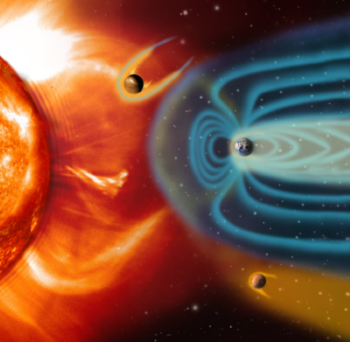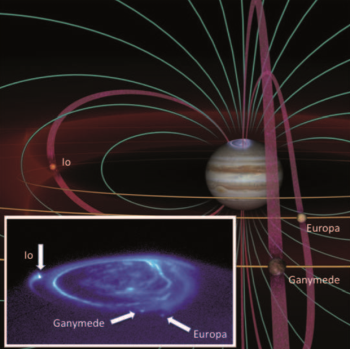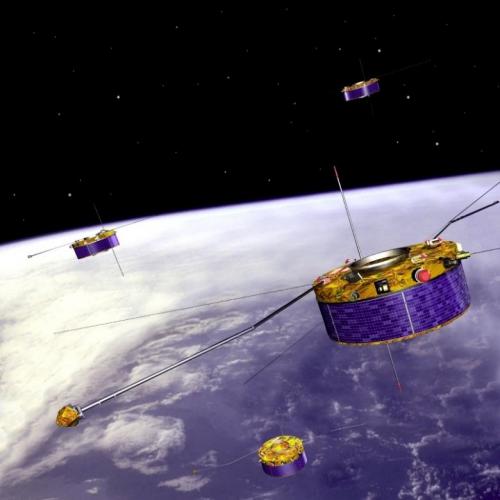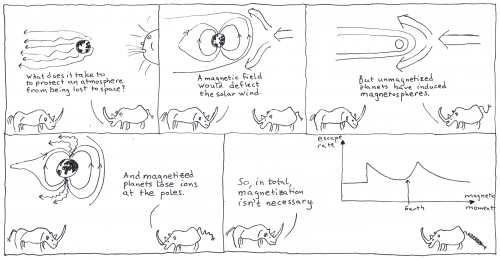A new book on the magnetospheres in our solar system has been published by Wiley. It has been co-edited by our BIRA-IASB colleague Dr. Romain Maggiolo. Based on 13 years experience in the “Magnetosphere” research team within the “Space Physics” department, he was approached to be the main editor of this book.
The Space Physics and Aeronomy collection from Wiley is a five-volume set of books presenting the latest scientific observations, models, and theories. Arranged sequentially, the books examine the Sun and the solar wind, magnetospheres in the Solar system, Earth's ionosphere, Earth's upper atmosphere, and the effects of space weather. This second volume, entitled “Magnetospheres in the Solar System”, is giving a comprehensive overview of current knowledge and future research directions in magnetospheric physics.
In the six decades since the term 'magnetosphere' was first introduced, much has been theorized and discovered about the magnetized space surrounding each of the bodies in our solar system. Each magnetosphere is unique yet behaves according to universal physical processes.
Magnetospheres in the Solar System brings together contributions from experimentalists, theoreticians, and numerical modelers to present an overview of diverse magnetospheres, from the mini-magnetospheres of Mercury to the giant planetary magnetospheres of Jupiter and Saturn.

Time for an interview with the main editor of the book
Maybe to start … what should we understand under the term ‘magnetosphere’?

shapes the magnetospheres of Earth (middle) and the
induced magnetospheres of Venus (top) and Mars (bottom).
Credits: ESA
The term magnetosphere refers to the region of space where physical phenomena are dominated by the magnetic field of a celestial body. For bodies with a global magnetic field generated in their solid core, such as the Earth, Saturn or Jupiter, the magnetosphere is relatively large. The Earth's magnetosphere is elongated, and extends to more than 50,000 kilometres away from the Earth on the side oriented towards the Sun and several hundred thousand of kilometres on the side away from the Sun.
Non-magnetised bodies that have an atmosphere, even tenuous, are also surrounded by a magnetosphere. This is the case for Venus and Mars, for example. The magnetic field is created by electric currents flowing in the upper atmosphere. This is known as an induced magnetosphere, whose dimensions are then reduced, their outer boundary reaching altitudes of only a few hundred kilometres on the sun side.
Why is it important to study these magnetospheres?
Magnetospheres are the interface between celestial bodies and their space environment. For the planets of the solar system, they constitute a region separating the atmosphere from the solar wind, a stream of electrically charged particles continuously emitted by the Sun. They can therefore play a protective role in shielding us from the Sun's wrath during solar flares. On the other hand, magnetospheres can also store energy and release it suddenly. These are called geomagnetic storms, which can have damaging consequences, especially for the power grid or satellites. The magnetospheres are also connected to the upper atmosphere of the planets, the most spectacular manifestation of this link being the polar auroras, the luminous emissions visible in the sky of the polar regions. We also wonder about the role that magnetospheres could have played on the stability of atmospheres, do they protect them or on the contrary do they contribute to their escape into space?
Magnetospheres are therefore an important component of the space environment of celestial bodies and as such constitute an interesting object of study. Each magnetosphere is unique, its properties depend on the properties of the celestial body: planet, moon or even comet. For example, the magnetosphere of Ganymede is located within the giant magnetosphere of Jupiter, which is itself strongly influenced by the presence of numerous satellites within it. Some planets have asymmetric magnetospheres, such as Uranus and Neptune, while others have small magnetospheres close to the Sun, such as Mercury. A transient magnetosphere even appears around comets when they are close enough to the Sun. Magnetospheres are complex systems coupled to both the solar wind and the ionosphere, the ionised part of the upper atmosphere. Within a magnetosphere itself, there are many sub-regions in which conditions can vary drastically. Thus, magnetospheres are natural laboratories for the study of plasmas, the gases of electrically charged particles of which the visible universe is almost entirely composed.

Jupiter’s Galilean moons. Jupiter magnetosphere is so large
that it encompasses the Galilean moons. The blue inlet is a
zoom into Jupiter’s polar region and displays Jupiter’s main
aurora where the auroral footprints of the moons Io, Europa,
and Ganymede are visible. (Image Credit: John Spencer and
John Clarke).
How can we study magnetospheres?
There is no single way to study magnetospheres. The very existence of magnetospheres was first deduced from theoretical considerations related to the interaction of the solar wind with planetary magnetic fields. Even before the advent of the space age, the indirect effects of electric currents flowing in magnetospheres were measured on the Earth's surface with magnetometers, instruments used to measure the magnetic field and its variations. Ground-based instruments are still used today, such as radar or networks of magnetometers distributed around the globe. Satellite measurements were a great leap forward. The first American satellite, Explorer 1, carried a Geiger counter that made it possible to discover the Van Allen belts, highly energetic particles trapped in the Earth's magnetosphere. With the development of increasingly sensitive instruments, multi-satellite missions such as the European Cluster mission and the American MMS mission, and the sending of numerous probes into the solar system, the quantity and quality of data is constantly increasing, providing us with an increasingly precise view of the physics of the magnetosphere. The development of computing capabilities allows the production of complex computer models that can simulate magnetospheres in a way that is ever closer to reality. Advances in our knowledge of magnetospheres require a combination of all these means, from theory to measurements to computer models.
Why was it decided to write a book on solar system magnetospheres?
The magnetospheres of the Solar System have been extensively studied over the last decades. The amount of data and knowledge accumulated is considerable because of the variety of magnetospheres in the Solar System and the means used to study them. It is therefore sometimes difficult to find one's way through the abundance of scientific literature and the variety of methods, tools and research topics. The same is true for other fields relating to our immediate space environment and the upper atmosphere. Two American researchers, Yongliang Zhang and Larry Paxton, have therefore proposed to Wiley, one of the largest scientific publishers, to publish a series of five books on these subjects: the thermosphere, the ionosphere, space weather, magnetospheres and the Sun. These books are primarily intended for thesis students and researchers. They must therefore be sufficiently accessible to provide an entry point to the subjects covered, but also sufficiently specialised to be useful to researchers specialising in these subjects. The aim is to collect as much information as possible in a single book, but also to structure it in such a way as to provide a global view of the topics and make it accessible to the reader.
Can you tell something about the content of the book?
This book consists of 47 chapters that can be read independently. The variety of topics covered in this book is quite large but they are always related to magnetospheres in the solar system. They cover both the history and physical principles, instrumental and numerical techniques, our current knowledge of the different regions of the Earth's magnetosphere and of other magnetospheres in the solar system. Finally, the last chapters discuss the still unsolved problems and give hints for the future development of research in this field. The book deals with the planets of the solar system, some of their satellites, comets, plasma physics, instruments and measurement methods, and numerical simulations.
Each chapter is written by renowned specialists. It is obviously impossible to cover all the topics related to magnetospheres in one book, even if it is 800 pages long. This book should therefore be seen as a guide to the complex world of magnetospheres. It provides a comprehensive overview of the subject and also contains a large number of references to direct the reader to the most relevant articles when a question needs to be explored in greater depth.
How did you get involved in this project and what was your role in the publication of this book?
I was approached to be the main editor of this book because of my experience in the subject and because of the expertise and reputation of the Royal Belgian Institute for Space Aeronomy in the field of space physics. From there, I chose three co-editors to assist me in this adventure: Nicolas André, a Frenchman, Hiroshi Hasegawa, a Japanese and Dan Welling, an American. The first step was to choose the structure of the book, the subject of the chapters and their authors. It was very important to give a coherent structure to the book but also to highlight the variety linked to this subject, both on a scientific and human level. We have authors of many nationalities, Asians, Europeans and Americans. This reflects the reality of magnetospheric research, which is international in nature and regardless of nationality or gender, what counts is the desire to discover, understand and share knowledge.
When authors have completed a first draft of their chapter, it is proofread by reviewers. They are chosen for their expertise and should have as little connection with the authors as possible, to ensure the most objective review process possible. I supervised this review process. Based on the feedback from the editors and with the help of the co-editors, it was my decision to validate the chapters. In addition, care had to be taken to ensure the uniformity of the book, taking care to maintain a certain balance and harmony between the chapters. Finally the production process started. I then acted as a liaison between the authors and Wiley, the publishing house. All this takes time, there is no question of accelerating the publication process if there is no consensus on the content of the chapters. So the project started at the end of 2017 and the book is only now being published.
The project involves 47 authors, often with several co-authors, and each chapter is reviewed by at least two researchers. This means that more than 200 researchers from all over the world have contributed to this project. From this point of view, it is a rather extraordinary human adventure. A lot happens in the lives of 200 people over three years!
Reference
Space Physics and Aeronomy Collection Volume 2: Magnetospheres in the Solar System, Geophysical Monograph 259, First Edition.Edited by Romain Maggiolo, Nicolas André, Hiroshi Hasegawa, and Daniel T. Welling.© 2021 American Geophysical Union. Published 2021 by John Wiley & Sons, Inc.DOI: 10.1002/9781119815624.ch1
- Table of Contents
- Access to the individual chapters
- Excerpt “A Brief History of the Magnetosphere” by David J. Southwood
Contact:
Dr. Romain Maggiolo
Researcher working in BIRA-IASB's “Magnetosphere” research team
Email: Romain(dot)Maggioli(AT)aeronomie(dot)be




